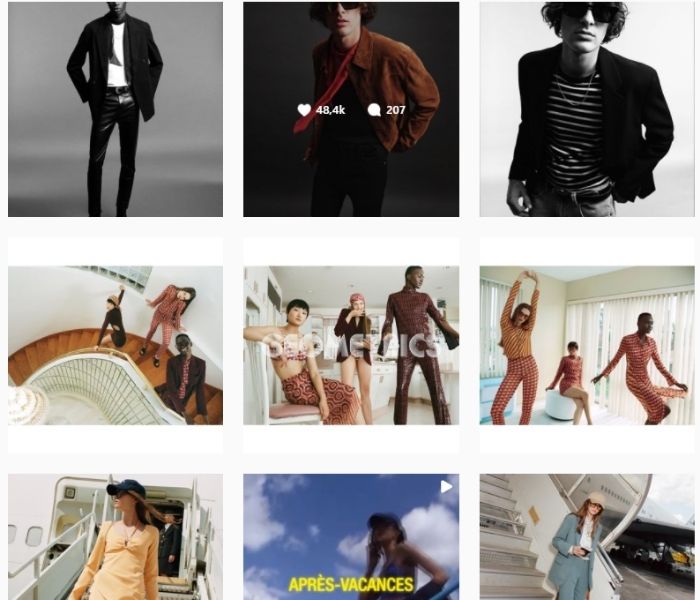How to get the most out of social media for fashion
Before we start, here’s a question: how many times have you looked at a brand’s social media before deciding to purchase their product or service? The answer probably varies depending on your generation, but we can’t deny that it’s an increasingly common habit (especially for Millennials and Gen Zs). Many brands are even discovered through social media!
Knowing how to strengthen social networks in the fashion and retail industry is more complex than it seems, given that it’s an industry with a lot of competition and it’s sometimes difficult to stand out on social media. Frequently, what happens is that despite a lot of effort, the desired results aren’t achieved; the target audience is not reached or there’s low engagement (which is one of the key factors to measure when knowing if you’re really connecting with your target audience).

Factors to keep in mind for fashion social media
The social media strategy for a fashion brand has to be well-defined, structured, and based on a business plan, as well as a sales plan. In both cases, three points must be very clear, which we’ll outline below:
-
Who are you targeting (Buyer Persona)?: analyze what social network they are on, their buying behaviors, and what type of content they consume.
-
What are your business goals?: it’s important to keep in mind where the brand is. Starting from zero and already having some brand awareness are very different.
-
How are you going to plan content for your fashion brand?: lay out benchmarks before starting to see what the competition is doing and collect ideas and references that can serve as inspiration.
Due to high competition and the amount of fashion brands that we see on social networks, we must keep the following in mind: if you want your content plan to work, it must be different and provide value. If it doesn’t, it’s very hard to increase your number of followers and maintain engagement over time.
In fact, many brands first create a profile with very attractive content that people like to share and that allows them to grow organically quickly; later, they release their own line of products. We can also see this strategy with influencers who create their own brand; their relevance and high number of followers serve as self-promotion.
4 keys to creating an effective social media strategy in the fashion industry
-
Create a consistent brand image online
First and foremost, it’s important to define your product strategy. You must make it very clear what you’re offering, if you have a product you want to specifically highlight, and how you are going to encourage buying your content. It’s also important to track your website traffic through social media.
Study your product/service well; learn about your possible competition and how they communicate on social networks. Look for the right tone according to your potential clientele (casual, friendly, professional, corporate, informative).
In this case, it’s very important to have a clear value proposal and brand guidelines so that everything is communicated coherently. The visual part and copy are the elements that play the biggest role in providing extra creativity and highlighting the retail and fashion industry. In fact, more and more brands are betting on texts that go beyond describing a product in its copy caption; they transmit feeling, inspiration, or motivation to further connect with their users.
To sum it up: in a world full of information, Instagram profiles, and constant notifications, creativity is what determines success.
Keeping all these factors in mind when creating your profile is imperative. Your bio should be organized in terms of content, be easy to read, and not filled with unnecessary information.
You must have a link to your website in your bio. In the case of Instagram and TikTok, for example, Linktree or Tap Bio work very well. They allow you to create a landing page with different, relevant links to the website that you can personalize according to your needs.
-
Increase fashion sales through social media
Once you have decided how you will communicate on social media, the next question is: how am I going to turn page visits into conversions? Here are 3 fundamental keys:
-
Improve your tracking: Every time you publish a link on social media, make sure you place a UTM parameter that will allow you to later identify in Analytics if the visit came from social media, from which network exactly, and if it is part of a special campaign. This factor is key when it comes to publishing organic content, creating ads, or collaborating with others. With this, we have constant visibility about what actions are working best based on the number of visits and conversions.
-
Social media ads: The question is, are social media ads truly effective for fashion brands? The answer is yes, but we have to plan them strategically. In this industry, remarketing is pretty effective, given that it reinforces the buying decision and reminds customers of the products they saw on the site. Many brands like Zalando use this strategy.
-
Collaborations and influencer marketing: Fashion brands are increasingly betting on influencer marketing to expand their brand and launch specials like offers, raffles, or discounts. The trend is to use micro influencers with more niche and specialized content (like shoe brands, for example).
-
Mobile first: the majority of social media usage is from phones; when you’re designing your fashion webpage, you must include a web-friendly design to encourage purchases.
-
Daily community management
It’s not enough to just create content; we must encourage user interaction through responding to their comments and messages, liking posts, and interacting with other accounts. To sum it up: be visible beyond your own profile. The more thought-out and creative your responses are, the more engagement you’ll have.
It’s essential to pay attention to the comments that your users leave. When facing any sort of online reputation crisis, ensure you have a response protocol that will help you solve these kinds of problems.
After this, focus on adequately coordinating response times, which means dealing with user needs and trying to resolve their doubts or suggestions in the shortest possible time.
-
Content is king
You must work hard and, above all, with your team. Let your imagination and wisdom run free (if you want to capture the attention of users).
Create images that “attract” easily and videos that provide value and entertainment and present content that transmits your brand’s values.
You can also play with creating infographics that sum up the content you are going to publish about your products, services, or other topics.

Make sure everything aligns with your brand. Use (on occasion and if necessary) humor, creating a connection between your brand and the user that makes the latter read your content and generate new sales. In addition, strengthen the specific aspects that each tool offers. For example, Instagram offers a lot: reels, stories, surveys, standard posts, carrousels, guides and more. If your target is on this network, don’t think twice about experimenting. Users love this kind of interaction.
When it comes to planning your editorial calendar, don’t forget to include posts that bring users to the webpage or encourage them to visit it. If you post a link, it’s important to track it with UTMs; this way, you can measure the traffic that arrives from that link.
Social networks that influence the fashion industry
As we mentioned earlier, the first step is analyzing which social network our target audience is on and on which we need to have a presence. It’s important to keep in mind that launching the same message on all networks isn’t effective; instead, we must plan both an omnichannel and personalized strategy, according to the social network on which we are communicating:
-
Instagram: Promote visual content and use the app’s different tools to promote engagement. Create eye-catching copy captions that attract the user's attention; otherwise, they will not stand out due to the information surplus. It's key to take into account the function of IG Shopping to promote sales, as in the case of 21 buttons, the social network for lovers of fashion shopping par excellence.
-
TikTok: More brands are using this social network to expand. It’s especially interesting to show the creation and creative process of collections; however; we must keep in mind that creating content on TikTok is more expensive than a standard publication, but it provides a greater creative touch and is especially useful for connecting with Millennials and Gen Z.
-
LinkedIn: This network is more oriented to offering content that relates to the brand, its values, and matters such as sustainability, equality, and more. It’s also useful to highlight employees as a main pillar of the value proposal.
-
Pinterest: Ideal for bringing out your more inspirational side and expanding the brand philosophy. Ulike Instagram, you can place a link on each post.
-
Twitter: A good option for interaction, creating debate, and informing users about the brand’s latest updates.
-
Facebook: With the boom of Instagram, Facebook was left a little behind, but it’s still an effective network to reach an older audience. Use Facebook Marketplace as a key tool to increase purchases.
Subscribe to our newsletter and stay up to date with the latest digital trends.
Subscribe to our newsletter and stay up to date with the latest digital trends.
No thanks. My inbox is fine as it is.